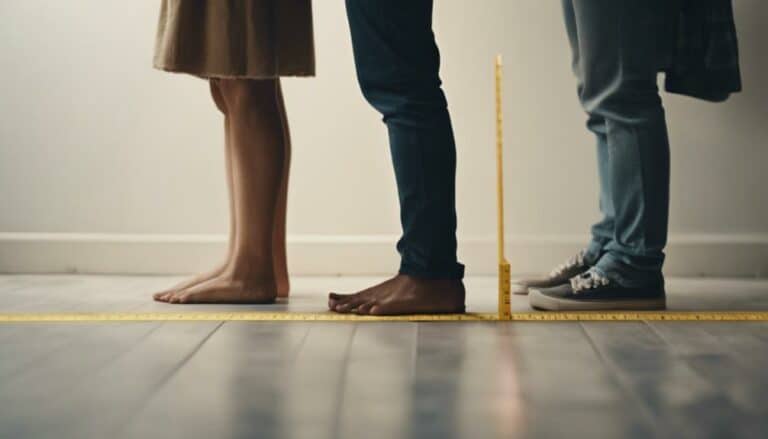When it comes to determining your height, do you measure with shoes on or off?
The choice might seem straightforward, but factors like precision and practicality can influence your decision.
Whether you opt for accuracy or convenience in height measurement, the debate between shoes on or off continues to spark interest and differing viewpoints.
So, how does this decision impact your overall height assessment and why does it matter?
Key Takeaways
- Measuring height without shoes ensures accuracy in medical assessments.
- Shoe thickness impacts height measurement precision.
- Consistency in measurement method aligns with precision needs.
- Stand against a wall barefoot for true reflection of physical stature.
Measuring Your Height With Shoes On
Have you ever wondered how measuring your height with shoes on can impact the accuracy of your measurement?
When you stand against a wall to measure your height, ensuring accuracy is key. To measure your height accurately with shoes on, it's crucial to stand flat against the wall, keeping your body straight. Make sure your heels are touching the wall, and your head is in a natural position. Using a flat object like a book to mark the highest point on the wall that aligns with the top of your head can help maintain precision.
However, bear in mind that measuring your height with shoes on may not provide the most accurate representation of your true height due to variations in shoe thickness. For a more precise measurement, consider measuring your height without shoes to eliminate any discrepancies caused by footwear.
Measuring Your Height With Shoes Off
When determining your height accurately for medical assessments or tracking growth, it's essential to measure without shoes to ensure precision and consistency over time. To accurately measure your height, stand as tall as possible with your back against the wall. Make sure to remove your shoes to get an exact measurement.
Using a measuring tape, determine your height without any footwear. It's crucial to stand straight and look straight ahead, ensuring that your body is aligned correctly. A mirror can be helpful to make sure you're standing upright. Doctors often require height measurements without shoes to obtain a true reflection of your physical stature.
Measuring your height without shoes is vital for calculating body mass index and accurately tracking growth. Barefoot measurement provides a more accurate representation of your true height, ensuring that medical assessments and health metrics are precise and consistent.
Considerations and Context
Considering various factors can help determine whether measuring height with shoes on or off is the most suitable approach for your specific needs.
In medical settings, where precision is paramount for assessing health metrics like body mass index, measuring height with shoes off provides a more accurate representation of your physical stature. Doctors often request shoe removal to ensure the measurements are as precise as possible.
However, for everyday practicalities or scenarios such as certain sports requirements, measuring height with shoes on may be more convenient. Understanding the context in which you're measuring your height and the type of shoes worn can guide your decision on whether to keep them on or take them off.
Ultimately, the key is to prioritize accuracy in height measurement, selecting the method that best aligns with the need for precision in the given situation.
The Bottom Line
To ensure accurate height measurements, it's essential to consider whether to keep your shoes on or take them off based on the context and need for precision. Knowing when to measure without shoes is crucial for obtaining an accurate measurement.
In medical settings, such as a doctor's office, height measurements are typically taken without shoes to ensure precise health metrics. Measuring with shoes on can introduce variability due to sole thickness, potentially affecting the accuracy of the results.
When measuring height, it's recommended to stand flat on the floor with your back perpendicular to the wall. Using a tape measure, you can then accurately determine your actual height without the interference of footwear. Consistency in how you measure your height is key for tracking growth or health progress effectively.
How to Determine Your Height Independently
For accurate self-measurements of your height, ensure you have a tape measure, ruler, or yardstick on hand in a flat, open space next to a wall.
To measure independently, stand on a hard, flat surface with your back, heels, head, and shoulders touching the wall. Stand straight against the wall, and use a small box or mark on the wall to ensure precise measurements.
Remember to take off your shoes for the most accurate measurement. If you don't have a measuring tool, create a makeshift ruler using a dollar bill, string, tape, and a marker for a quick solution.
This method allows you to determine your height accurately without assistance, ensuring reliable results. By following these steps and utilizing the tools needed, you can easily measure your height independently and with confidence.
Conclusion
You must always measure your height with your shoes on to ensure accurate results. Removing your shoes may lead to drastic changes in your height measurement, affecting your overall perception of yourself.
So, remember to always keep those shoes on when measuring your height for the most precise and reliable results!

